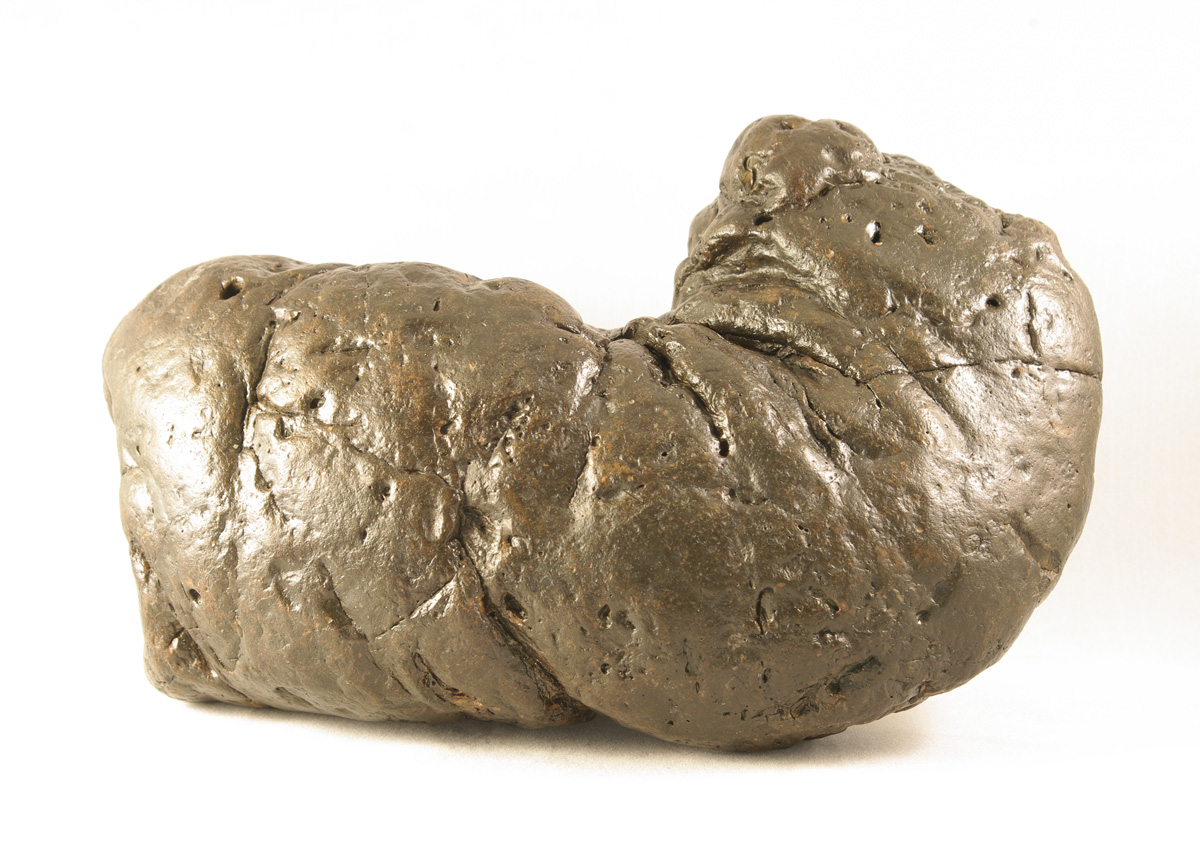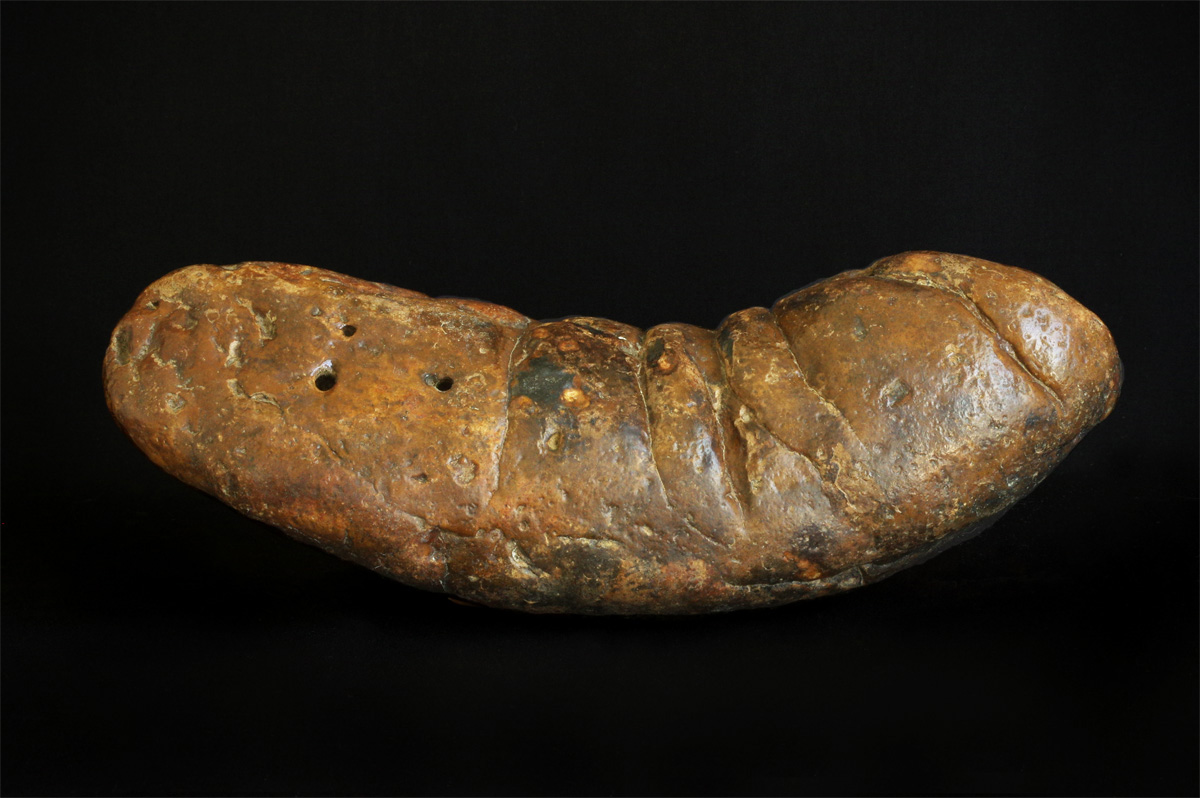Coprolite with Distinct Vertebrate Bite Marks.jpg on:
[Wikipedia]
[Google]
[Amazon]



 A coprolite (also known as a coprolith) is fossilized
A coprolite (also known as a coprolith) is fossilized



 A coprolite (also known as a coprolith) is fossilized
A coprolite (also known as a coprolith) is fossilized feces
Feces ( or faeces), known colloquially and in slang as poo and poop, are the solid or semi-solid remains of food that was not digested in the small intestine, and has been broken down by bacteria in the large intestine. Feces contain a relati ...
. Coprolites are classified as trace fossils as opposed to body fossils, as they give evidence for the animal's behaviour (in this case, diet) rather than morphology. The name is derived from the Greek words κόπρος (''kopros'', meaning "dung") and λίθος (''lithos'', meaning "stone"). They were first described by William Buckland in 1829. Before this, they were known as "fossil fir cones" and " bezoar stones". They serve a valuable purpose in paleontology because they provide direct evidence of the predation and diet of extinct organisms. Coprolites may range in size from a few millimetres to over 60 centimetres.
Coprolites, distinct from '' paleofeces'', are fossilized animal dung. Like other fossils, coprolites have had much of their original composition replaced by mineral deposits such as silicate
In chemistry, a silicate is any member of a family of polyatomic anions consisting of silicon and oxygen, usually with the general formula , where . The family includes orthosilicate (), metasilicate (), and pyrosilicate (, ). The name is al ...
s and calcium carbonates. Paleofeces, on the other hand, retain much of their original organic composition and can be reconstituted to determine their original chemical properties, though in practice the term coprolite is also used for ancient human faecal material in archaeological contexts.
Initial discovery
British fossil hunter Mary Anning noticed as early as 1824 that " bezoar stones" were often found in the abdominal region ofichthyosaur
Ichthyosaurs (Ancient Greek for "fish lizard" – and ) are large extinct marine reptiles. Ichthyosaurs belong to the order known as Ichthyosauria or Ichthyopterygia ('fish flippers' – a designation introduced by Sir Richard Owen in 1842, altho ...
skeletons found in the Lias formation at Lyme Regis. She also noted that if such stones were broken open they often contained fossilized fish bones and scales as well as sometimes bones from smaller ichthyosaurs. These observations by Anning led the geologist William Buckland to propose in 1829 that the stones were fossilized feces
Feces ( or faeces), known colloquially and in slang as poo and poop, are the solid or semi-solid remains of food that was not digested in the small intestine, and has been broken down by bacteria in the large intestine. Feces contain a relati ...
and name them coprolites. Buckland also suspected that the spiral markings on the fossils indicated that ichthyosaurs had spiral ridges in their intestines similar to those of modern sharks and that some of these coprolites were black with ink from swallowed belemnites.
Research value
By examining coprolites, paleontologists are able to find information about the diet of the animal (if bones or other food remains are present), such as whether it was aherbivore
A herbivore is an animal anatomically and physiologically adapted to eating plant material, for example foliage or marine algae, for the main component of its diet. As a result of their plant diet, herbivorous animals typically have mouthpart ...
or a carnivore, and the taphonomy of the coprolites, although the producer is rarely identified unambiguously, especially with more ancient examples. In some instances, knowledge about the anatomy of animals' digestive tracts can be helpful in assigning a coprolite to the animal that produced it, one example being the finding that the Triassic dinosauriform
Dinosauromorpha is a clade of avemetatarsalian archosaurs (reptiles closer to birds than to crocodilians) that includes the Dinosauria (dinosaurs) and some of their close relatives. It was originally defined to include dinosauriforms and lager ...
''Silesaurus
''Silesaurus'' is a genus of silesaurid dinosauriform from the Late Triassic, of what is now Poland.
Discovery
Fossilized remains of ''Silesaurus'' have been found in the Keuper Claystone in Krasiejów near Opole, Silesia, Poland, which is al ...
'' may have been an insectivore, a suggestion which was based on the beak-like jaws of the animal and the high density of beetle remains found in associated coprolites. Further, coprolites can be analyzed for certain minerals that are known to exist in trace amounts in certain species of plant that can still be detected millions of years later. In rare cases, coprolites have even been found to contain well-preserved insect remains.
Recognizing coprolites
The recognition of coprolites is aided by their structural patterns, such as spiral or annular markings, content, undigested food fragments, and associated fossil remains. The smallest coprolites are often difficult to distinguish from inorganic pellets or from eggs. Most coprolites are composed chiefly of calcium phosphate, along with minor quantities oforganic matter
Organic matter, organic material, or natural organic matter refers to the large source of carbon-based compounds found within natural and engineered, terrestrial, and aquatic environments. It is matter composed of organic compounds that have c ...
. By analyzing coprolites, it is possible to infer the diet of the animal which produced them.
Coprolites have been recorded in deposits ranging in age from the Cambrian
The Cambrian Period ( ; sometimes symbolized C with bar, Ꞓ) was the first geological period of the Paleozoic Era, and of the Phanerozoic Eon. The Cambrian lasted 53.4 million years from the end of the preceding Ediacaran Period 538.8 million ...
period to recent times and are found worldwide. Some of them are useful as index fossils, such as ''Favreina'' from the Jurassic period of Haute-Savoie in France.
Some marine deposits contain a high proportion of fecal remains. However, animal excrement is easily fragmented and destroyed, so usually has little chance of becoming fossilized.
Coprolite mining
In 1842 the Rev John Stevens Henslow, a professor of Botany atSt John's College, Cambridge
St John's College is a Colleges of the University of Cambridge, constituent college of the University of Cambridge founded by the House of Tudor, Tudor matriarch Lady Margaret Beaufort. In constitutional terms, the college is a charitable corpo ...
, discovered coprolites just outside Felixstowe in Suffolk
Suffolk () is a ceremonial county of England in East Anglia. It borders Norfolk to the north, Cambridgeshire to the west and Essex to the south; the North Sea lies to the east. The county town is Ipswich; other important towns include Lowes ...
in the villages of Trimley St Martin, Falkenham
Falkenham is a village and a civil parish in the East Suffolk district, in the English county of Suffolk, near the village of Kirton and the towns of Ipswich and Felixstowe. The population of the civil parish as of the 2011 census was 170.
Des ...
and Kirton and investigated their composition. Realising their potential as a source of available phosphate once they had been treated with sulphuric acid
Sulfuric acid (American spelling and the preferred IUPAC name) or sulphuric acid ( Commonwealth spelling), known in antiquity as oil of vitriol, is a mineral acid composed of the elements sulfur, oxygen and hydrogen, with the molecular formu ...
, he patented an extraction process and set about finding new sources.
Very soon, coprolites were being mined on an industrial scale for use as fertiliser due to their high phosphate content. The major area of extraction occurred over the east of England, centred on Cambridgeshire and the Isle of Ely with its refining being carried out in Ipswich by the Fison Company. There is a Coprolite Street
Coprolite Street is a street in Ipswich, Suffolk in the Waterfront area. It runs from Duke Street to Neptune Marina, the former Orwell Quay. It was named after the factory which processed coprolite, or fossilised faeces
Feces ( or faeces ...
near Ipswich docks where the Fisons works once stood.
The industry declined in the 1880s but was revived briefly during the First World War to provide phosphates for munitions. A renewed interest in coprolite mining in the First World War extended the area of interest into parts of Buckinghamshire
Buckinghamshire (), abbreviated Bucks, is a ceremonial county in South East England that borders Greater London to the south-east, Berkshire to the south, Oxfordshire to the west, Northamptonshire to the north, Bedfordshire to the north-ea ...
as far west as Woburn Sands.
See also
*Bromalite
Bromalites are the fossilized remains of material sourced from the digestive system of organisms. As such, they can be broadly considered to be trace fossils. The most well-known types of bromalites are fossilized faeces or coprolites
A co ...
* Fecalith
A fecalith is a stone made of feces. It is a hardening of feces into lumps of varying size and may occur anywhere in the intestinal tract but is typically found in the colon. It is also called appendicolith when it occurs in the appendix and is ...
* Fossil
* Fossils and the geological timescale
The geologic time scale, or geological time scale, (GTS) is a representation of time based on the rock record of Earth. It is a system of chronological dating that uses chronostratigraphy (the process of relating strata to time) and geochro ...
* Gastrolith
* Guano
Guano (Spanish from qu, wanu) is the accumulated excrement of seabirds or bats. As a manure, guano is a highly effective fertilizer due to the high content of nitrogen, phosphate, and potassium, all key nutrients essential for plant growth. G ...
* Lloyds Bank coprolite
The Lloyds Bank coprolite is a large coprolite, or fossilised specimen of human faeces, recovered by the York Archaeological Trust while excavating the Viking settlement of Jórvík (present-day York) in northern England.
Description
The coprol ...
* Regurgitalith
Regurgitaliths
are the * ''
are the * ''
The World of Poo
''The World of Poo'' is an illustrated children's book written by Terry Pratchett and illustrated by Peter Dennis. It is based on the book featured in Pratchett's ''Discworld'' novel ''Snuff'', in which Sam Vimes reads it to his now older son, r ...
''
* Petrifaction
In geology, petrifaction or petrification () is the process by which organic material becomes a fossil through the replacement of the original material and the filling of the original pore spaces with minerals. Petrified wood typifies this proce ...
* Petrified wood
Notes
References
* * {{Authority control Trace fossils Feces Animal waste products